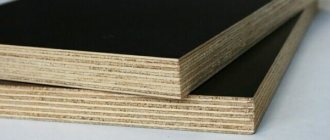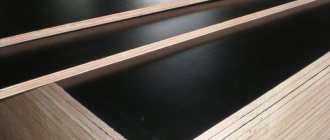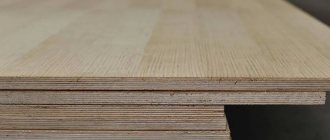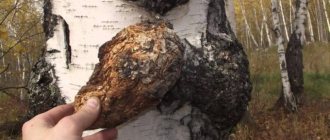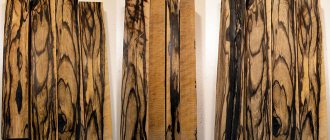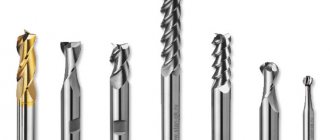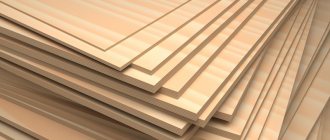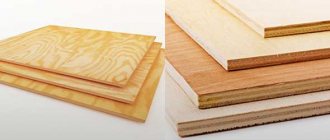Bakelite (bakelized, “marine”) plywood is a multilayer building material made from birch veneer, bonded together using special phenol-formaldehyde resins with thermal activity. It has particularly high strength and wear resistance. This type of plywood acquires such exceptional qualities comparable to it as a result of special processing, which consists of impregnating the internal and external layers of veneer with bakelite varnish. The material obtained by this method has improved moisture resistance and high strength characteristics.
Brands and varieties of bakelite plywood
Plywood, which is often called “marine”, can be used in temperatures ranging from -50 to +50 C⁰. It does not rot, is not affected by fungi and bacteria, which allows it to be used in countries with hot climates (tropics and subtropics) and in coastal areas. Duration of operation is about 15 years.
Modern industry produces two brands of bakelite plywood: FBS and FBV, made on the basis of water-soluble resins. In turn, they are also divided into several main types: FBS, FBS - 1, FBS - 1A, FBV, FBV -1.
At the same time, the letter “A” in the marking of the material indicates the possibility of its use for interior work, “B” - the content of water-soluble resins in the plywood, and “C” - alcohol-soluble resins.
To achieve better strength and resistance to various types of mechanical, bacteriological and chemical influences, bakelite plywood is laminated.
The technical description and scope of application of bakelite plywood of the above grades are presented in the table:
| Brand | Description | Use Cases |
| FBS | All layers of veneer are impregnated with an alcohol-soluble resin based on phenol-formaldehyde. The outer layers are made from 1st grade veneer, and the inner layers are made from 2nd grade. Has high strength. Not flammable. | Design of cars, machines, ships, construction. Interior work. |
| FBS-1 | The strength of the material is lower. The resin is applied to all layers of veneer using the coating method. | Design of cars, machines, ships, construction. Internal work. |
| FBS-1A | All veneer layers, except the transverse ones, are coated with alcohol-soluble resin. Made entirely of grade 2 veneer. It has the lowest price and poor resistance to difficult weather conditions. | Interior work. |
| FBV | The water-soluble resin impregnates the outer layers of veneer, the inner ones are only coated. | Structural parts of machines and units in mechanical engineering. Use in outdoor conditions only after additional protection with paints and varnishes. |
| FBV -1 | All layers of veneer are coated with water-soluble formaldehyde resin. | Structural parts of machines and units in mechanical engineering. Use in outdoor conditions only after additional protection with paints and varnishes. |
Laminated bakelite plywood has a very smooth, glossy, hard surface. It is easy to care for, very durable and non-toxic. It can be smooth on both sides or smooth on one side (mesh on the other). A variety of the latter type (with a smooth mesh surface), called transport plywood, is used for the manufacture of anti-slip floors in the bodies of trucks.
Photo of bakelite plywood
Main varieties
Today, bakelite plywood is available in two types:
- FBS, which is impregnated with alcohol-soluble resin;
- FBV, the manufacturing features of which involve the use of water-soluble resin.
Also, this building material is produced with a polished or unpolished surface. To prevent plywood from swelling during operation, its ends are treated with a special bakelite varnish or enamel. The FBS grade has the highest strength, which is made by completely immersing the veneer in bakelite, which allows you to impregnate not only the inner layers of the material, but also the outer ones. FBS has the following properties:
Types of bakelite plywood.
- increased strength;
- moisture resistance;
- wear resistance;
- good resistance to aggressive environments;
- fire protection;
- resistance to fungus and mold.
FBS plywood can be produced in the following versions:
- FBS-1. It is a material with reduced strength. Its production technology is based not on impregnating the internal and external layers with bakelite, but on coating them.
- FBS-A. The outer and inner layers are coated with bakelite resin. This type of moisture-resistant board is less environmentally friendly than the previous one, so it is mainly used for the design of internal elements in the field of mechanical engineering.
- FBS-1A. All layers of the sheet, except the transverse ones, are treated with alcohol-soluble resin. This is the cheapest type of bakelite plywood, which has low resistance to negative external conditions.
Bakelite plywood FBV is manufactured in accordance with GOST 11539-83 from birch veneer with the application of synthetic phenol-formaldehyde water-soluble resin to both internal and external layers.
The nature of production makes it possible to obtain an elastic, wear-resistant, water-resistant and high-strength building material, the outer layers of which correspond in quality to grade B.
Properties and technical specifications
You can distinguish bakelized plywood from regular plywood by color: it is slightly darker, with a red-brown tint.
Standard material parameters:
- Dimensions - 5700x1250 mm, 2850x1250, 2500x1250 mm, 2440x1220 mm.
- Thickness - 7, 10, 12, 15, 18, 21, 24, 27 mm.
- Material density - 1200 kg/m3.
- Tensile strength along the fibers is 73.5 MPa.
- Static bending strength – 78.5 MPa.
- Standard parameters of laminated plywood are 1220x2440 mm, 1250x2500 mm, 1500x3000 mm.
- Sheet thickness: 4, 6, 9, 12, 15, 18, 21, 24, 27, 30 mm.
- Width of veneer strips: not less than 200 mm. For the FBS brand – at least 400 mm.
One of the main advantages of bakelite plywood is its high strength, comparable to the strength of high-quality alloy steel. In addition, this material has other positive properties.
These include:
- High moisture resistance.
- Durability.
- Not subject to delamination during operation.
- Fire resistance. When the temperature is significantly exceeded (up to 350 C⁰), it becomes charred and does not support combustion. At the same time, the smoke generated during the smoldering process does not have a pronounced suffocating or toxic effect.
- Good resistance to bacteriological and chemical influences (not afraid of kerosene, sea water, weak acids, alkalis, gasoline, not damaged by fungus and mold).
- Environmental Safety.
That is, rating this material on a five-point scale, you can assign it “fives” in the areas of quality, reliability and practicality. In addition, it deserves an “excellent” rating for its simplicity and ease of use. The only thing that can slightly reduce points when evaluating bakelite plywood is its high cost.
Advantages and disadvantages
Bakelite composite has many advantages over other construction and finishing materials, combining the properties of natural wood and high-strength plastic:
- versatility: due to high strength, water resistance and fire resistance, it can be used in many industries;
- during operation it is not damaged by harmful chemical compounds: alkalis, fuels and lubricants, kerosene, alcohol;
- environmental safety: does not emit toxic impurities into the air, can be used in the interior decoration of residential premises;
- aesthetics, plywood does not require additional finishing, except in special cases;
- much lighter than steel and other materials of similar strength and wear resistance.
Bakelite plywood has few disadvantages, and they are all relative. These include:
- high specific gravity compared to other composites containing wood. Furniture and decoration made from it will put pressure on the supports - this must be taken into account when using;
- high price is the main disadvantage. The cost of one thin sheet of grade FBS-1 is at least 2,300 rubles, FBS - from 3,500 rubles and more. Such types of work using it, such as disposable formwork, become simply impractical.
Stages and features of production
The “bakelite” component used in the production of bakelite plywood was invented at the beginning of the 20th century by the American chemist, Leo Hendrik Baekeland, who obtained it from phenol and formaldehyde with the addition of alkaline-type condensing substances.
This polymer was the first plastic capable of operating at high temperatures. In addition, it had dielectric properties and was not soluble in water. Bakelite then began to be used as one of the main components for the production of special grade plywood. It was made using birch veneer, impregnated or coated with phenol-formaldehyde resins.
Today, the production technology of this material consists of several stages:
- Depending on the grade and brand of the final product, the veneer is completely immersed in resin or lubricated with it on both sides.
- The veneer layers are laid perpendicular to each other and pressed at a pressure of up to 4 MPa.
- While under pressure in the press, the plywood is cooled to the required temperature, after which, if necessary, it undergoes additional processing (lamination, sanding, etc.) and cut to specified standards.
Areas of use
As mentioned above, modern bakelite plywood sheets are used in a variety of applications. That is why they are so popular and in demand. Let’s take a closer look at the areas in which you can’t do without high-quality and wear-resistant bakelite plywood.
- In the construction industry. In most cases, the material in question is used in various types of construction processes. Often, entire floating docks, sluices and water seals are constructed from bakelite plywood. Also, the sheets can be used to make very strong formwork, designed for repeated use. Bakelite plywood makes excellent supporting structures, canopies, partitions and other small or large architectural structures. Marine plywood is often combined in construction work with other varieties of this material.
- Automotive building. Another area in which the material in question is used with enviable frequency. Bakelite plywood is used to make very strong and wear-resistant floors in various vehicles (equipment can have different purposes). Few people know, but even car vans are made from such elements.
- Shipbuilding. Bakelite plywood has proven itself very well in the construction of ships. It is very often used for high-quality deck covering and for various parts of boats. Reliable sea containers are made from sheet material.
- Mechanical engineering. Bakelite plywood is widely used in modern mechanical engineering. It produces very strong and reliable components of various structures and mechanisms.
- Marine plywood is often used in the furniture industry. It is used to make very strong and durable structures that do not require special care.
The considered material is used not only for the manufacture of serious structures, such as boats, poles or supports, but also for the most ordinary internal and external cladding of houses.
See below for a review of laminated plywood.
Historical prologue
It is an airplane and not a train in Africa.
The invention itself belongs to the domestic chemist and inventor Yakov Davidovich Avrasin, who in the 40s of the 20th century, using formaldehyde resins, gave plywood the qualities that made it possible to construct airplanes from this material. The need for the invention was caused by an acute shortage of light aircraft alloys.
The idea was picked up and implemented by Vladimir Petrovich Gorbunov, a famous domestic aircraft manufacturer.
The process itself went as follows:
- Birch or pine veneer, after manufacture, was impregnated with either cresol-formaldehyde or phenol-formaldehyde resins;
- After this, thermal pressing was carried out using high pressure (270 degrees Celsius, a pressure of 6 atmospheres);
- The result: at the end we have a strong puff pastry, comparable in strength to steel, somewhat heavier than wood, but also stronger.
From history to modern times
Cars with plywood bodies.
Currently, aviation has reserved this material only for the so-called small aviation. The focus of application has shifted from aircraft construction to shipbuilding. And although it is clear that no one will make the hulls of ocean liners from this material, baked plywood is quite suitable for boats, boats, and yachts.
A few words about technology:
During numerous experiments, it was noticed that birch veneer is much superior to coniferous veneer in its ability to be impregnated with special impregnations (in this case, bakelite varnish);
Regarding properties
Plywood can be used in the construction of boats.
Like every material, plywood has its own standards, which determine the quality of the product and the possibility of its use in modern industry. All features of bakelite puff can be found in GOST 11539 83 for bakelite plywood.
Let's talk about this in a little more detail:
- Water resistance. This property is achieved through the same special impregnations or varnishes. The material is not afraid of either fresh or salt water;
- Fire resistance. Products made from such material do not burn. At a temperature of 350 degrees Celsius, plywood begins to char and does not support active combustion. The smoke that is released during this process does not have a pronounced suffocating effect;
- Not susceptible to rot or fungus. In principle, this says it all, plywood does not need additional protection or impregnation, and there is no need for lamination;
- Heat resistance. The material feels great with sudden temperature changes in the range of 100 degrees Celsius. Products made from it can withstand sudden temperature changes from -50 to +50 degrees Celsius;
- Strength. Due to the different arrangement of veneer fibers, the material has good strength and is able to withstand significant loads in both direct and lateral directions.
About application and brands
Widely used in construction.
You already have an idea of what bakelized plywood is. It is necessary to go through the area of application in order to completely dot the i’s.
So, baked plywood is used in:
- Shipbuilding – plating of small vessels, including small sea yachts;
- Automotive industry – body floors, sides, containers, trailers;
- Construction work - erection of formwork for building reinforced slabs, columns and other building structures directly on site. For the construction of canopies, partitions and other large and small architectural forms;
- Hydraulic engineering - production of hydraulic locking equipment - hydraulic locks, sluices and similar elements.
According to the types of impregnations, which largely determine the properties of plywood, the material is divided into grades.
Namely:
A boat made of plywood has not surprised anyone for a long time.
To facilitate the price component, some additional brands were thought out and introduced, the price of which is lower than those completely impregnated with phenol-formaldehyde varnishes. These are FBS-A, FBS1-A. In these cases, some layers are subjected to impregnation, for example, all but the two central ones.
As you can see, there are only two brands: FBS and FBV, which means baked plywood with alcohol-soluble varnish and the same thing, but with water-soluble varnish.
From brands to sizes
The shape - a leaf - determines a lot.
All plywood sheets are available in several sizes:
- The area is 5700x1250, 2850x1250. Dimensions are given in millimeters;
- Thickness ranges from 5 to 40 mm; the most popular, especially when constructing boats, boats, and gliders with your own hands, is plywood from 5 to 18 mm.
Production and brands
Deciduous and coniferous wood veneers
are used , the outer layers are made of birch, less often poplar, alder, and hornbeam are used on special orders. The material is calibrated and soaked to obtain a moisture content convenient for processing.
Further stages of production :
- The veneer is processed on a cutting-format machine, where the material receives the required dimensions.
- Dried in closed chambers in rolls, which are suspended for uniform action of hot air, the raw materials are moved by a roller conveyor.
- Dry raw materials are additionally rejected and sent to the production workshop.
- The veneer is spread on tables, cleaned, and grouped into piles by size.
- First, the internal frame is made of coniferous veneer, all sheets are coated with bakelite varnish and resins.
- Then do the same with the veneer for the outer surface.
- The fibers of the subsequent layer are placed perpendicular to the previous one.
- The resulting “pie” is dried and then pressed with a thermal press.
Under pressure, the necessary components melt, and the material gains strength. The resulting plywood is additionally laminated, sanded, and cut to the required dimensions. There is an option when the layers are not coated with resin, but the entire stack is dipped into the solution.
Bakelized plywood is available in the following grades:
- FBS. The outer coating is impregnated with phenol-formaldehyde mastic, soluble in alcohol. The inner layers are not processed, but only compressed.
- FBS – 1 . The outer and inner layers are impregnated with phenol-formaldehyde alcohol-soluble mastic.
- FBV. Water-soluble formaldehyde mastics are used outside, but not inside.
- FBV – 1. Water-soluble formaldehyde is used on the inner frame and outer layers.
- FBS1 - A. All layers are impregnated with an alcohol-containing resin solution, except for the transverse ones, located symmetrically from the middle layer.
The USSR State Committee adopted and published standards for the manufacture and production of bakelized plywood by Resolution No. 4828 of October 10, 1983 .
Some information about bakelite plywood
It is impossible to find in the world a more unique and durable material with a wide spectrum of action, like baked plywood. What it is? Bakelite plywood is veneer sheets that are treated with a special glue, thanks to which the material gains a lot of possibilities. It is worth noting that many people have not even heard of it, since previously it was used purely for industrial purposes. However, with the development of interior design and people’s desire to create the most comfortable home possible, FB plywood gradually began to capture the construction market.
All the unique properties of bakelized plywood are given by its component – bakelite. This chemical was created by Leo Baelando in 1909, who (not) modestly named the material after himself. In simple terms, Bakelite is organic formaldehyde crossed with phenol during reaction with an alkaline solvent. Due to the high presence of carcinogenic materials in the mixture, plywood treated with such glue should not be used to treat the interior surfaces of a living space, but it performs remarkably well when used externally.
Bakelized plywood was invented in the 1940s by our compatriot Ya. D. Avrasin, who in this way solved the emerging shortage of wood for building aircraft. It was he who came up with the idea of treating plywood with bakelite to obtain the so-called delta wood. With its help, the legendary I-22 fighter was created by the hands of V.P. Gorbunov, a Soviet designer. This plane gave rise to the people’s parable about a plywood plane and tanks, which is not so far from the truth.
His experience was quickly borrowed by other powers, such as Japan. This country has always had a shortage of timber, so they used bakelite plywood to create an armada of fighter planes with kamikaze pilots at the wheel. Bakelite plywood is still used in aircraft construction, but recently, due to its characteristics, it is gradually moving to the construction market.
